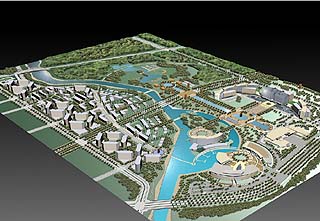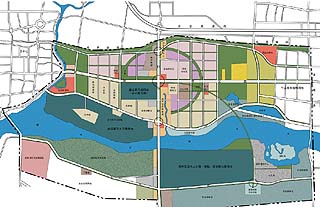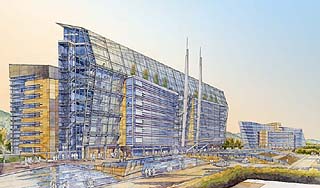
Surveys
DJC.COM
November 21, 2002
Local architect has big designs on China
MulvannyG2

Zhang |
The quiet Shunyi District is faced with the need to build supporting infrastructure to accommodate the world in six years. The district, home to 2.5 million people and located only 40 minutes from downtown Beijing, is blessed with incredible landscape and the breathtaking Chao-bei River that winds through it.
It is because of its proximity to Beijing and its natural water features that the district was selected to host the equestrian performance, boating, rowing and kayaking Olympic events. The agricultural community is known for its fruit, fine beer and wines. (Think Yakima, but with 20 centuries of history).

Graphic courtesy MulvannyG2 The master plan for the district administrative center. The lower right-hand corner is the cultural center and marina. The building on the middle right-hand side is the convention center and in the upper right corner are the district administration buildings. |
After meeting the demands of the Olympics, the community’s goal is to develop the district into a sustainable, ecological tourism district with a strong theme of sports, agriculture and water activities.
The Shunyi-American connection
Land use and urban planning is still a new concept in China and the Shunyi government was looking forward to implementing newer urban planning concepts. The government had tried working with two different firms to develop the land-use plan, and had not been pleased with the results.
The firm awarded the contract for the master planning of the Olympic Green and Olympic Park was U.S.-based Sasaki Associates. With over 86 firms, many firms needed to carefully evaluate whether it was worth the effort and resources necessary to compete.
MulvannyG2 elected not to throw its hat into the ring of 86 firms. Instead, it bypassed the International Olympic Committee review process and approached the small city directly for its urban planning needs, which just happened to include hosting support facilities for some of the Olympic events.
The firm had the advantage of strong ties to China and a design portfolio with five significant projects in China in the past six years. The imminent opening of a new office in Shanghai signified dedication to the market. Many of the “guanxi” — or connections — by which the Chinese economy continues to operate were already in place with MulvannyG2.
Interestingly, being a Western firm also gave MulvannyG2 a competitive advantage. The firm was able to present the Chinese with a more advanced, creative and environmentally-sensitive solution than they had previously seen.

The land-use plan for the Shunyi District.
|
Life beyond the Olympics
The land-use plan developed for the Shunyi District covers 10,000 acres and includes more than six major land-use zones: Olympic sports, tourism, commercial, residential, cultural-institutional and government-administration. The main planning concept combines the Olympic events with abundant agricultural plantation areas, tourism sections and other existing natural resources, such as the Chao-bei River.
The overall goal is to help position the district as a recreational area. The entire plan was based on the theme of “connections,” including: visual connections, physical connections via pathways and waterways, and ultimately, psychological connections.
Overall, it was felt that the area needed a better distribution of density. We introduced the concept of mixed-use commercial in an urban setting, high-density residential in the urban core, and a man-made canal that provides additional waterfront retail and recreational opportunities. There is an 80-meter-wide green belt encircling the core that helps visually separate the mixed-use from low-rise residential areas. The target population for the site in 10 years is 100,000.
The first plan was extremely well received and the firm began work immediately on the master plan for a district administration center and auxiliary facilities along with office buildings and a convention center with a hotel-restaurant complex. There is also a cultural center that will serve the museum, library, opera house and music hall functions in four separate buildings.
The 360-acre site is located on the edge of the “old” Shunyi District, and the plan would revitalize a blighted area into a thriving, cultural center by using the district administration center site as a bridge between the old and the new areas. It also addresses residential development and public green space and parks. A pedestrian pathway connects the entire site.

Rendering courtesy MulvannyG2 A concept rendering of the district administration building. |
The result is an ecologically sensitive plan that provides a visual and cultural link between the old, historic areas of the district and the new urban areas.
Entering the Chinese market can be a challenging process. Legislation and approval procedures for most foreign activity can be bewildering and arbitrary as Chinese authorities experiment with new regulations. However, China’s entry into the World Trade Organization in December 2001 resulted in a reduction of certain tariffs and trade barriers, allowing companies like MulvannyG2 to actively pursue business there without many of the bureaucratic obstacles that were once present.
As a result, the Chinese are benefiting from the architectural practices of Western firms. Conversely, Western firms and their clients are benefiting from an expanded world-view in design and architecture.
Ming Zhang is vice president in charge of design at Bellevue-based MulvannyG2 Architecture.
Other Stories:
- Ten high-rise office building design trends
- Mixed-use and maximum value
- The big picture shows small schools
- Retail RX
- Architects welcome low income housing challenge
- Hospital renovations can make people sick
- Engaging the community with 'Design Dialogue'
- To green or not to green?
- Getting the most from environmental graphics
- Watch out for changes to stormwater regs
- Tunneling in Seattle: the long and short of it
- Making the workplace work even harder
- How to take your firm to the ‘next level’
- Seattle firms look back on a tough year
Copyright ©2009 Seattle Daily Journal and DJC.COM.
Comments? Questions? Contact us.